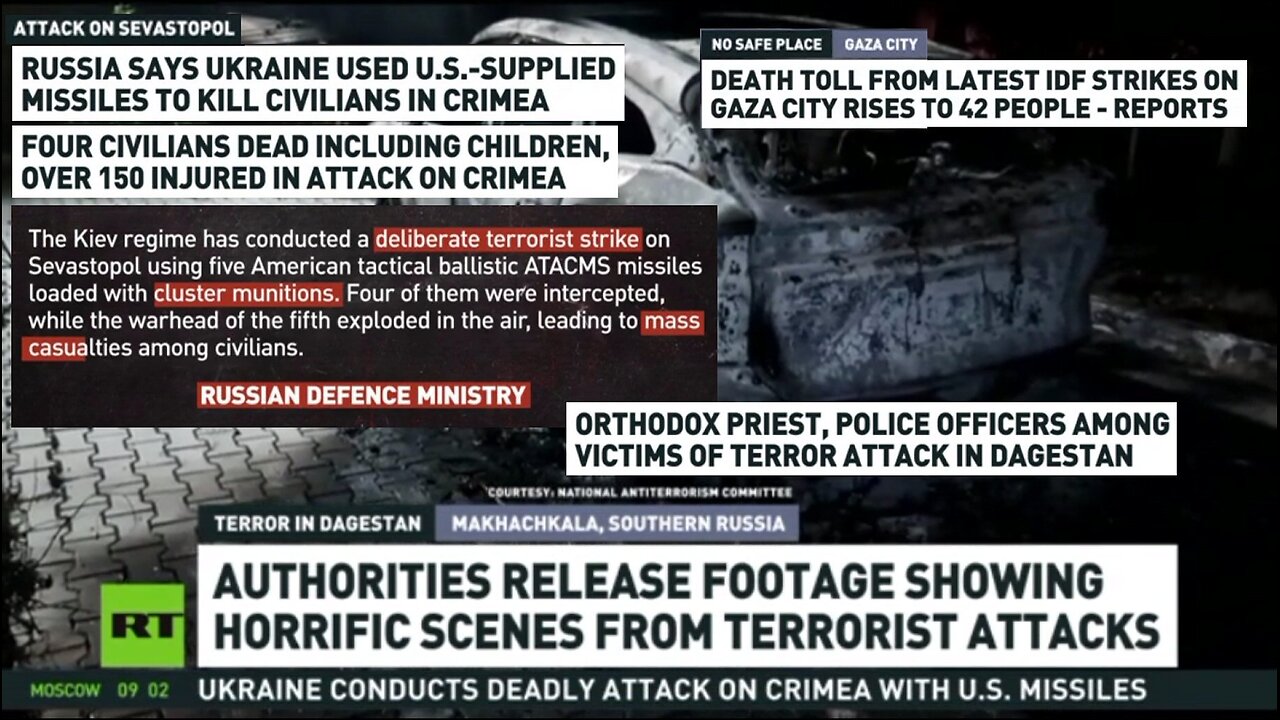Premium Only Content

RT News - June 24 2024 early. Terror attacks in Dagestan, Crimea hit with US ATACMS
(Warning, disturbing footage.) In Dagestan, five terrorists have been killed after they attacked churches and synagogues in Dagestan. (Makhachkala, the capital and Derbent a large city about 120km south). Many civilians have died as well as 15 policemen who confronted and tried to stop the terrorists and a security guard who tried to secure the door of a church.
The Head of the republic, Sergey Melikov, talks of the awful event and confirms the elimination of the terrorists. An Orthodox priest had his throat cut by a terrorist, a synagogue was set on fire.
Dagestan is predominantly Muslim but all religions are present there, living peacefully together (it's a really beautiful country). Yesterday was a holiday across Russia, "Holy Trinity".
Roman Kosarev reports from Makhachkala. Aduklhakim Gadzhiev (Russian Federal Lawmaker) talks of posts made to Telegram social media about such an event warned of at the airport; the posts were made by channels registered as Ukraine.
More details below.
In Sevastopol, Crimea on Sunday, a beach full of tourists came under attack by ATACMS missiles loaded with cluster bombs. The attack killed four people and injured another 150. Two of the dead are children. Five such cluster bomb filled missiles were fired at the citiy of Sevastopol. The US made ATACMS missiles need specialist US personnel to fire them as well as intelligence from US surveillance planes or other intelligence for coordinates. Please see yesterday's report as well as more reporting from Donald Courter and reports below. People who were at the beach yesterday talk of the attack.
(the cost of an ATACMS missile is around $1 million each. Cluster bombs are primarily used for anti-personnel and are of little use for "hard targets" although they do cause damage, see https://en.wikipedia.org/wiki/Cluster_munition , it's almost unimaginable that five of ATACMS would be loaded with cluster bombs and aimed at a city full of civilians. It's unthinkable to me.)
-----------
Israel/Gaza/Lebanon. The IDF have conducted strikes against Lebanon last night after IDF announced "the approval of the offensive". It followed cross border exchanges. A US military spokesman has warned that such attacks could bring Iran into the conflict and spark a larger regional conflict.
The IDF have continued with attacks and strikes on Gaza, at least 25 more civilians have been killed bringing yesterday's death count to at least 42. The carnage and devastation was enormous. There is no safe place for civilians anywhere.
The West Bank has also come under fire from the IDF with deadly raids. Maria Finoshina reports. Disturbing images, Khaled Warad, an Al-Fara refugee camp paramedic speaks with Maria and a lady sheltering/hiding inside her home.
----
The Houthis have continued to strike vessels bound for Israel. The Dwight B Eisenhower is on it's way home.
Short take: Five terrorists are killed after they conducted a series of deadly attacks on churches and synagogues in the southern Russian Republic of Dagestan. Their victims included an Orthodox priest and several police officers. Ukrainian forces used US missiles to conduct a deadly strike on the city of Sevastopol in Crimea. Palestinians in a West Bank refugee camp seek shelter after an Israeli raid that left several people dead, including a 16-year-old boy.
1) Pentagon has ‘nothing to say’ about strike on Crimean beach with US-supplied weapons 24 Jun, 2024 00:28
Washington is providing the intelligence data for Kiev’s ATACMS strikes, the Russian Defence Ministry has stated
The Pentagon has refused to comment on the deadly Ukrainian cluster munition attack on a crowded beach in Russia’s Sevastopol on Sunday, Russian news agency RIA Novosti has reported. The Ukrainian attack, carried out by US-supplied ATACMS missiles, killed at least four people, among them two children, and injured some 151, according to local officials.
Four missiles were intercepted by air defences, while a fifth deviated from its final trajectory and detonated its cluster warhead over the busy Black Sea beach, the Russian Defence Ministry said in a statement on Sunday.
When RIA asked the Pentagon about the use of US supplied weapons in the strike on Sunday, an official replied “we have seen the reports and have nothing to say.”
Moscow has placed the blame primarily with Washington, accusing it of enabling the “premeditated terrorist missile attack.” The targets for these US-provided missiles are assigned to Ukrainian troops by American specialists, based on their own intelligence data, the Defence Ministry stated.
According to data from the flight tracker Flightradar, a US RQ-4B Global Hawk reconnaissance drone was patrolling in the Black Sea south of Crimea during the Ukrainian missile strike.
The number of people injured by the strike stood at 151 as of Sunday night, according to Sevastopol’s governor, Mikhail Razvozhaev. A joint team of specialists from the Health Ministry’s Federal Centre for Disaster Medicine has arrived in the city to work with the victims, he wrote early on Monday.
Kiev deliberately picks mass gatherings of people as targets, both out of hatred and to sow panic, Russian Foreign Ministry spokeswoman Maria Zakharova said following the attack. The day of the Holy Trinity holiday was picked deliberately, she claimed.
Ukraine has previously targeted the Crimean Peninsula with US-provided ATACMS missiles. In May, ten ATACMS were shot down on the trajectory aimed at the strategic Crimean Bridge, Russian Defence Minister Andrey Belousov stated at the time.
===============================================
2) Terrorist attacks in southern Russia: What we know so far 24 Jun, 2024 00:08
Terrorists have targeted synagogues, churches, and the police in the Russian region of Dagestan
The southern Russian region of Dagestan was rocked on Sunday by a series of deadly attacks in two major cities, which claimed the lives of multiple civilians and at least 15 police officers, as assailants deliberately targeted synagogues and Orthodox Christian churches.
Where did it happen
Dagestan is one of several Muslim-majority regions in Russia’s Northern Caucasus, that stretches along the coast of the Caspian Sea. The tragic scenes unfolded in the regional capital Makhachkala, and Derbent, a large city some 120 km to the south.
Derbent attacks
During a raid on a Christian church in the city, militants brutally killed its archpriest, Father Nikolay Kotelnikov, security officials have confirmed. The gunmen broke into the church on Pentecost Sunday, after the evening service and reportedly slit the 66-year-old’s throat, after killing a guard.
The Derbent synagogue that came under attack had recently strengthened its security, with a police squad stationed outside and private security guards on the premises, according to the Russian Jewish Congress, a national religious organization.
The police and security personnel were the first to confront the gunmen and were killed by the attackers, who raided the synagogue some 40 minutes before an evening prayer. The terrorists then used firebombs to set the building on fire.
Makhachkala attacks
Violence in the regional capital apparently began with a raid on a traffic police post. Among multiple videos circulating online, one features a group of three men. Two of them are firing weapons while the third appears to be looting a police car.
Little confirmed information about the events in Makhachkala was immediately available. The Russian Jewish Congress confirmed that a synagogue in the city was attacked in a similar manner to the one in Derbent.
Some media outlets claimed that militants had taken hostages at a Christian church in Makhachkala, but reports later clarified that over a dozen people had barricaded themselves inside due to a firefight nearby. They were never in danger, according to Dagestan officials.
Counter-terrorist operation
The manhunt in Derbent lasted for several hours. The police chief from the neighboring town of Dagestanskie Ogni came to aid fellow officers and was fatally injured by the militants, the regional Interior Ministry reported.
The National Antiterrorism Committee (NAC) declared the active phase of the operation in Derbent was over around 11pm local time, confirming that two assailants had been neutralized.
The counter-terrorist operation in Makhachkala was still ongoing as of 2am local time, with at least three militants killed and authorities still searching for possible accomplices, according to the governor of the Republic of Dagestan, Sergey Melikov.
Casualties
Reports of the death toll have been inconsistent. Authorities confirmed at least 15 fatalities among police officers, and “several” civilian casualties.
The regional Interior Ministry said that a total of 16 people, including 13 policemen, had been rushed to the main regional hospital in Makhachkala throughout the day.
Perpetrators
Multiple media reports that cited police sources claimed that two of the militants killed in Makhachkala were identified as sons of a municipal head. The man was reportedly arrested and is likely to lose his job, according to the press. Other Russian officials described the gunmen as members of an international terrorist organization.
‘Diabolic’ goal
Representatives of Russian Jewish, Christian and Muslim communities have universally condemned the attacks on the places of worship. The Dagestan Muftiate called such brutality antithetical to Islam.
Patriarch Kirill, the head of the Russian Orthodox Church, suggested that the perpetrators were seeking to incite religious hatred and called that goal “diabolic”.
“Everything possible must be done to prevent even the possibility of radicalization of religious life, to exclude any forms of extremism and ethnic enmity,” he urged.
==================================================
3) Washington took the side of international terrorism – Moscow 24 Jun, 2024 03:23
Kiev could not have attacked Crimea with ATACMS missiles without US participation, ambassador Anatoly Antonov has said
The US administration demonstratively supports Kiev in its unjustifiable terrorist strikes against Russian civilians, Moscow’s ambassador Anatoly Antonov has told the press. Ukraine attacked Russia’s Sevastopol on Sunday, using US-provided ATACMS missiles with cluster munition warheads, killing at least four people and injuring at least 151, including dozens of children.
While four of the missiles were intercepted by air defenses, a fifth veered off course and detonated its cluster warhead over a busy Black Sea beach and its weekend crowd, the Russian Defense Ministry reported.
The Ukrainian attack was purposefully carried out when there was a maximum concentration of people on the beach, Antonov told journalists when asked to comment on Washington’s lack of reaction to the deadly strike.
The administration demonstratively supports the crimes of the Kiev regime. It took the side of international terrorism, and condones attacks on civilians by Bandera’s adherents,” the Ambassador stated.
“It is obvious to policymakers in Washington that cluster munitions in ATACMS missiles cannot be launched without the participation of American specialists and support from US intelligence. It is no coincidence that enemy drones are circling over the Black Sea almost every day,” he added.
“All this indicates the death of America’s pseudo-humane foreign policy in the bloody swamp of the Ukrainian crisis,” the diplomat said.
The Russian Defense Ministry has pinned the blame for Ukraine’s “premeditated terrorist missile attack” on Washington, accusing it of both supplying Kiev with the ATACMS missiles, and providing intelligence and reconnaissance data on Russian targets.
According to Sevastopol’s governor, Mikhail Razvozhaev, at least four people, of them two children, were killed in the missile strike. The number of wounded has risen to 151 as of Sunday evening. A joint team of specialists from the Ministry of Health has been dispatched to the city to help the victims. Meanwhile, Bomb disposal crews are working on scene and combing the beach for potential unexploded submunitions of the ATACMS cluster warhead.
=========================================================
4) Ukraine’s deadly attack on Sevastopol: As it happened 23 Jun, 2024 14:42 LIVE UPDATES
Kiev has struck the Crimean city with US-supplied ATACMS missiles, killing four people and injuring more than 120
16:21 GMT
Abandoned bags and toys – this is what the beach in Sevastopol looks like after Ukraine’s ATACMS missiles attack. Traces of blood and scattered belongings of tourists can be seen at the scene of the tragedy.
Minesweepers are clearing the beach in Sevastopol of explosives, while divers are checking the sea. The coast is completely cordoned off. Fragments of missiles armed with cluster warheads can be seen on the road to the beach. The police and special teams of the Russian Emergency Ministry and other departments are working at the location.
15:59 GMT
In footage published online, a resident of Sevastopol who was at the beach during the missile strike describes how her husband shielded her.
“We were at the beach in Uchkuevka with our relatives at that moment. I can’t find words to describe this horror and nightmare,” she said. “Everything happened in a matter of seconds. We didn’t have time to run away or hide anywhere.”
They laid face down in the sand and covered their ears, the woman said.
“My husband laid on me and covered me with himself.” Numerous people, including children, suffered in the attack, the woman went on to say, adding that she saw children covered in blood screaming.
15:55 GMT
June 24 has been declared a day of mourning in Crimea following the deadly attack, the head of Crimea, Sergey Aksyonov, said.
More than 20 ambulance crews are working at the scene. Doctors from other regions were also brought in to assist the wounded, including a team of specialists from the Federal Center for Disaster Medicine.
15:31 GMT
Footage from a popular Black Sea resort near Sevastopol emerged online, purportedly showing the moment that a US-supplied ATACMS missile launched by the Ukrainian army detonated in the air. The video shows people who were at the beach running in panic.
The Russian Defense Ministry said in a statement that Washington bears responsibility for the Ukrainian missile strike, since its specialists input flight missions into US missiles. The strike targeting civilians in Sevastopol will not go unanswered, the ministry added.
15:12 GMT
The death toll in the Ukrainian shelling of Sevastopol has risen to five, including three children, the city’s governor, Mikhail Razvozhaev, told reporters. At least 124 people have been injured, including 27 children, five of whom are in intensive care, Russia’s Health Ministry said.
Russian President Vladimir Putin is in constant contact with local authorities, as well as the military and health officials in Sevastopol, Kremlin spokesperson Dmitry Peskov said earlier.
==============================================
5) Russia strikes Ukrainian pilot training hub 3 Jun, 2024 20:33
A missile barrage was launched at the site from the Black Sea
Russian forces struck a training center for Ukrainian pilots with long-range missiles on Sunday morning, the Russian Defense Ministry has said in a statement. The barrage was one of a series of devastating attacks the ministry claimed were carried across the entire Ukrainian front line.
“This morning, the Armed Forces of the Russian Federation launched a group strike with high-precision, long-range, sea-based weapons at the training site for flight and technical personnel of the Ukrainian Air Force,” the ministry’s statement read. “All designated targets were hit,” the statement added.
The ministry did not specify where the strike took place. However, Russian forces regularly use missiles and drones to attack military airfields and troop concentrations deep behind Ukrainian lines.
As Kiev has not yet received any Western fighter jets, Ukraine typically stations its Soviet-era MiG-29 and Su-27 fighters at these airfields.
Belgium, Denmark, the Netherlands, and Norway have all pledged to supply Ukraine with a total of 85 F-16 fighters, and Ukrainian pilots are currently being trained on these American jets in the US, Denmark, and Romania. French President Emmanuel Macron has also promised to supply Ukraine with Mirage 2000 fighter jets.
Moscow has vowed to destroy these Western fighters on the tarmac in Ukraine. State Duma Defense Committee Chairman Andrey Kartapolov warned earlier this month that foreign airfields would also be considered “legitimate targets” if such facilities are used to carry out sorties and strikes against Russian forces.
“As for [our ability] to shoot [them] down, we can shoot down anyone, anywhere,” the MP added.
Russian Foreign Minister Sergey Lavrov has also warned that Moscow would perceive the deliveries of F-16 fighters to Ukraine as a nuclear threat, given that the jets have long been used as part of NATO’s joint nuclear missions.
Between Saturday and Sunday, Russian forces engaged Ukrainian targets along the entire front line, from Kharkov Region in the northeast to Kherson in the south. The Ukrainian military lost more than 1,900 troops in 24 hours, the ministry said, along with dozens of military vehicles and artillery pieces.
==================================================
6) Russia can only rely on itself when it comes to weapons – Putin 23 Jun, 2024 21:35
A sustainable defense sector is the basis for the nation’s security, the president has said
Russian President Vladimir Putin has stressed the importance of steady supplies to the military and a robust defense sector in ensuring the nation’s security. Russia can only rely on its own resources, he added.
Speaking to journalist Pavel Zarubin, Putin addressed the importance of the effective and sustainable management of the defense sector by the Defense Ministry. Everything, including soldiers’ pay and new equipment orders, depends on it, the president said, adding, “it is very important. It is the basis.”
“We can only rely on ourselves in this regard,” Putin told Zarubin. “No one will come to us with open hands and just donate anything. We can only do it on our own. And we are succeeding.”
In late May, Putin insisted that “every ruble” spent on the armed forces should be used effectively. Funding should not only provide for the needs of the military, but “fit in” with the national economy as well, he stated.
Russia has ramped up its defense industry amid the conflict with Ukraine. In May, the head of defense conglomerate Rostec, Sergey Chemezov, said the production of self-propelled artillery pieces increased tenfold, and production of towed guns grew by 14 times.
The output of ammunition rounds for tanks and infantry fighting vehicles increased by 900%, artillery shells by 600%, and munitions for MLRS by 800%, according to Chemezov, whose corporation supplies around 80% of the arms used by the Russian military in the conflict.
Russia’s defense industry capabilities have sparked concerns among Kiev’s Western backers. Ukraine mostly relies on foreign military aid in the conflict with Moscow. In February, The Guardian reported that the growth of Russia’s defense industry production was much higher than many Western defense planners expected.
“We still haven’t seen where Russia’s breaking point is,” Mark Riisik, the deputy director in the policy planning department of Estonia’s Defense Ministry, told the news outlet.
In March, CNN reported that Russia was about to produce three times more artillery shells than the US and EU combined. The US military set a goal to produce 100,000 artillery rounds per month by the end of 2025, the broadcaster said at the time, adding that it was “less than half of the Russian monthly output.”
Moscow has warned that supplies of Western weapons to Ukraine will only prolong the conflict without changing the outcome. According to Germany’s Kiel Institute for the World Economy, which tracks Western financial and military aid to Kiev, Washington and its allies have already spent tens of billions of dollars on weapons for Ukraine.
The US leads the list of Kiev’s biggest donors with €50.4 billion ($53.89 billion) spent on weapons. Germany and the UK come second and third with €10.2 billion and €8.8 billion respectively.
Russia has been on the offensive in recent months, making steady gains in Donbass and launching a new operation in Kharkov Region in May.
====================================
7) Over 100 draft dodgers try to flee Ukraine daily – official 23 Jun, 2024 16:03
Most of the fugitives are caught by on-duty officers, the head of a Border Service department has said
Over 100 Ukrainians attempt to flee the country every day by various routes in an effort to escape mobilization, a senior Border Service official has said, admitting that the real number could be even higher.
In an interview with the news agency Unian on Saturday, Igor Matviychuk, who heads the Border Service’s Control Department, said that this figure includes both those who try to leave Ukraine by illegally making their way through checkpoints and those who seek to cross through poorly guarded terrain in the wilderness.
Matviychuk also noted that the statistics include either those detained by Ukrainian patrols and officials, or those reported by foreign authorities. He stated that most draft dodgers are being caught, but that this offense is punishable only by a fine. However, Matviychuk added that those who mastermind schemes to help Ukrainian men illegally leave the country could face criminal charges.
The official’s comments come as Ukrainian journalist Vitaly Glagola reported that the Ukrainian authorities on Friday detained an organized group of as many as 47 men attempting to flee the country for Moldova in Odessa Region in what appears to be the largest single arrest of draft evaders since the start of the conflict.
Ukraine announced a general mobilization shortly after the hostilities with Russia began, barring most categories of men between the ages of 18 and 60 from leaving the country. However, this effort has been marred by widespread graft and draft-dodging. More recently, faced with mounting battlefield losses, Kiev passed a law that lowered the draft age from 27 to 25 and another that significantly tightened mobilization rules.
At the same time, attempts to escape mobilization have proven fatal in some cases. Ukraine’s Border Service said earlier this month that more than 45 Ukrainian men had died in rough terrain while fleeing the country, adding that a significant portion of them drowned in the Tisza River, which flows through southwestern Ukraine, Romania, Hungary, Slovakia, and Serbia.
The agency also admitted last week that its operatives had resorted to firing shots to stop draft dodgers from fleeing the country.
===============================================
8) Philippines to probe US anti-vax propaganda campaign – Reuters 23 Jun, 2024 16:31
The Pentagon-run operation was reportedly intended to misinform people about China’s Covid vaccine
Philippines lawmakers are planning to launch an investigation into an undercover propaganda campaign conducted by the US military to cast doubt on the Chinese Covid-19 vaccine at the height of the pandemic, Reuters reports, citing documents.
The Philippines was among the nations that suffered the worst from coronavirus infection rates in the region, as the country’s authorities struggled to persuade people to get vaccinated.
The move comes in response to allegations that a Pentagon-run operation to smear the Chinese vaccine Sinovac was conducted between spring 2020 and mid-2021. The campaign focused on the Philippines before spreading to other countries in Asia and the Middle East, Reuters reported earlier this month, citing former US military officials.
The campaign reportedly used fake social media accounts impersonating locals to criticize Sinovac and spread claims that test kits and masks produced in the country were of poor quality.
Documents seen by the news agency reportedly show that Philippines Senator Imee Marcos, who chairs the Foreign Relations Committee, and House Representative France Castro filed resolutions in the Philippines Congress earlier this week to initiate an investigation into the allegations.
According to the resolution from Marcos obtained by Reuters, the Senate inquiry is aimed at determining “the ramifications of the actions of the US Military, any potential breach of international law” by Washington, as well as “the possible legal recourse” available to the country, considering that misinformation campaigns such as this “[threaten] national security.” The documents claim that “underhanded tactics by a foreign military power” undermined “national sovereignty and the democratic rights of Filipinos to freely access truthful information vital to public health and safety.”
The US military was engaged in an undercover propaganda campaign to smear Chinese vaccines in developing countries during the coronavirus pandemic, Reuters cited a senior US Defense Department official as saying.
A Pentagon spokeswoman told the media that US defense forces deploy “a variety of platforms, including social media, to counter those malign influence attacks aimed at the US, allies, and partners.” The spokeswoman went on to claim that Beijing conducted a “disinformation campaign to falsely blame the United States for the spread of Covid-19.”
=== related from 15 Jun, 2024 Pentagon ran secret disinfo campaign against Covid vaccine – Reuters
Hundreds of fake social media accounts linked to the US military were reportedly used to spread fear about the Chinese jab in Asia
The US military staged an undercover social media campaign at the height of the pandemic to smear the Chinese Covid vaccine, Reuters has reported.
The Pentagon’s campaign to disparage the Chinese vaccine ran between the spring of 2020 and mid-2021, focusing on the Philippines before spreading to other parts of Asia and the Middle East, the agency claimed in an article on Friday.
It relied on fake social media accounts impersonating Filipino users to disseminate claims that China’s Sinovac vaccine, as well test kits and face masks produced by the country, was of poor quality.
Sinovac, which began being rolled out in March 2021, became the first jab available to the Philippines during the pandemic.
“COVID came from China and the VACCINE also came from China, don’t trust China!” a typical post as part of the campaign, which centered on the #ChinaAngVirus (China is the virus) slogan, read, according to Reuters. Another commonly encountered post claimed: “From China – PPE, Face Mask, Vaccine: FAKE. But the Coronavirus is real.”
Furthermore, the Pentagon tried to convey to Muslim users in Asia and the Middle East that due to the fact that vaccines sometimes contain pork gelatin, China’s jab should be forbidden under Islamic law, the report read.
Reuters said that its investigation found at least 300 accounts on Twitter, which had since been re-branded as X, that matched the descriptions provided by the former US military officials who told journalists about the campaign.
The agency said that it had contacted X about the accounts and that the Elon Musk-owned platform had determined – based on activity patterns and internal data – that the profiles in question were part of a coordinated bot campaign. The accounts have been deleted, it added.
A senior US Defense Department official confirmed to Reuters that a clandestine social media campaign against Sinovac did take place, but declined to reveal further details.
A Pentagon spokesperson told the agency that the US military “uses a variety of platforms, including social media, to counter those malign influence attacks aimed at the US, allies, and partners.” Beijing was the one to start a “disinformation campaign to falsely blame the US for the spread of COVID-19,” she claimed.
========================== FEATURE
9) The death of the petrodollar: What really happened between the US and Saudis? 23 Jun, 2024 14:40
News about the expiration of a Washington-Riyadh deal may be fake, but an arrangement that is key to the dollar’s success has eroded
It is said that works of fiction can often convey certain truths better than a newswire. That is perhaps the light in which to view reports circulating around the internet recently about the expiration of a 50-year ‘petrodollar’ treaty between the US and Saudi Arabia.
The agreement is a piece of fiction. The spurious reports appear to have originated in India or in the murky tangle of websites aimed at crypto investors. There was an official agreement between the US and Saudi Arabia signed in June of 1974 and another, secret one reached later that year according to which the Saudis were promised military aid in exchange for recycling their oil proceeds into US Treasuries. The deal whereby Riyadh would sell its oil in dollars was informal, and there was no expiration date. The petrodollar system as we have come to known largely grew organically.
However, this fiction points to an underlying truth: the petrodollar has entered a long twilight from which there will be no return. No other economic arrangement has done more to ensure American preeminence over the last half-century. Yet in its essence it represented an implicit oil backing to the dollar that would be maintained. To borrow an idea originally expressed by financial analyst Luke Gromen, it is ultimately America’s inability and unwillingness to maintain this backing that is gradually dooming the system.
Origins of the petrodollar
When the US abandoned the dollar’s gold peg in 1971, thus ending the Bretton Woods arrangement, the international financial system was thrown into chaos. What ensued was a turbulent period of high inflation and major adjustments to the new reality of free-floating currencies. Untethered from even the pretense of a gold backing, the dollar unsurprisingly devalued and inflation ran rampant. By the summer of 1973, it had lost a fifth of its value against other major currencies.
This should have marked the end of the two and a half decades of post-war dollar primacy. And yet quite a peculiar thing happened: the dollar’s role as reserve currency and primary instrument of trade only expanded. The reason is that the Americans managed to steer the oil trade into dollars, starting with the Saudis in 1974 and soon thereafter extending to all of OPEC. This established a de facto commodity backing for the dollar. Since the oil market is much larger than the gold market, it actually gave the dollar even greater scope.
In exchange for agreeing to sell their oil in dollars, Saudi Arabia became a protectorate of the US military. Many have seen this deal as a Godfather-like “offer you can’t refuse” for the Saudis. After all, Secretary of State Henry Kissinger and Defense Secretary James Schlesinger attracted considerable attention in early 1975 by refusing to rule out the possibility of taking over foreign oil fields using military force in the event of a “strangulation” of the West by oil-producing countries. Although the US-Saudi oil deal predates these remarks, it’s not a stretch to imagine that the Kingdom regarded coming under the US tent as a safer move than waiting around to find out how the word “strangulation” would be defined.
It probably was a good bet. Many things have transpired in Saudi Arabia in the intervening half century, but one thing that has resolutely not happened is a color revolution or US regime-change operation.
The de facto oil backing and the exception that proved the rule
The dollar thus went from being pegged to gold under Bretton Woods to being unofficially backed by oil. And indeed, after the shock in 1973-74, oil traded in a remarkably stable range of roughly $15-30/per barrel for the next 30 years. This remarkable stability lies at the heart of the success of the petrodollar arrangement. There was one important exception to this stability, but even it ended up only buttressing the system.
That exception is the oil shock of 1978-79, sparked by the Iranian Revolution, when oil surged well above the upper end of this range. This coincided with (and partly caused) a deep crisis in the dollar and raging inflation in the US. It was at this time that Fed chairman Paul Volcker embarked on his famous series of aggressive rate hikes.
Volcker’s tough medicine was aimed at breaking the back of the worst US inflation in history, but no less important was the effect it had on bolstering the frayed credibility of the dollar. A New York Times article from the time complained that the Fed chairman’s moves “make clear that international considerations, and specifically the defense of the dollar, are now influencing American economic policy to a degree unparalleled in the postwar period.” In other words, Volcker was being accused of prioritizing the functioning of the dollar system over domestic considerations.
It’s important not to get too bogged down in untangling cause and effect here, or in seeking in Volcker’s actions an explicit petrodollar angle. The oil market during those years was responding to a host of factors, and it was by no means within the power of the Fed to manage it. Nor was Volcker explicitly trying to do so. But he was very aware of the pain high crude prices caused oil importers and the threat to the stability of the system it posed.
Volcker’s decisive action restored the dollar as the world’s most preferred currency, and the stronger greenback did help keep oil cheaper in the greenback than in other currencies. Most importantly, however, the perception was created that the US was willing to subject its own economy to pain (Volcker put the US through two punishing recessions) in order to preserve the value of the dollar for all global players holding or transacting in dollars.
Oil prices came down in the early ‘80s and basically stayed within the $15-30 range for the next twenty or so years. A lot of this had to do with major new sources of oil coming online, such as the North Sea, Alaska, and Mexico. However, the bottom line is that the dollar preserved its value against oil. It doesn’t even really matter how much of this is an actual achievement of US policy and how much is just a confluence of favorable circumstances. What matters is that the dollar was seen as equivalent to oil, and the Volcker years had created the impression that the US would actually defend it in a time of crisis and manage it fairly. That made holding dollars (or US Treasuries) a reasonable proposition for all.
A 30-year range breaks and the rest is history
Fast forward to 2003, and the oil price began a long and steady ascent. This is largely attributable to rising Chinese demand and the geological realities that many of the world’s major legacy fields were peaking and starting to turn over, meaning the easy-to-extract oil was becoming scarce (It’s more accurate to think about peak ‘cheap’ oil than the actual geological peak.) The dollar also weakened substantially against other major currencies over 2003-2008, a circumstance economist Steve Hanke believes caused 50% of the oil price surge during that period.
Importantly, when oil moved to the top of its 30-year range, it didn’t stop. Over the next couple of years, oil prices would rise steadily before peaking at $145 per barrel in July 2008. Again, another way to think about this is a drop in the value of the dollar against oil, an ominous development for those holding dollars and buying oil.
This is the moment when a fatal crack appeared in the foundation of the petrodollar edifice. With oil surging and the dollar weak, where was a new swashbuckling Paul Volcker to come in and tighten policy, strengthen the dollar at whatever cost, and preserve its implicit oil backing? The answer: nowhere to be found. In fact, quite the opposite happened. During the crucial period when crude was rising in 2007 and early 2008, the US actually cut interest rates in response to a weakening economy, thus exacerbating the problem.
Luke Gromen sees this episode as causing an important epiphany for many nations who had been aggregating foreign currency reserves with a belief that the dollar would continue to be managed to be as good as gold for oil, and that the US would not pursue policies that would have the effect of impoverishing energy importers.
Making matters worse was the deluge of bailouts and trillions in quantitative easing in the aftermath of the 2008-09 financial crisis, which contributed to the sense that the US would spare no effort to stabilize its own faulty banking system – the dollar be damned. It had also become apparent that the US economy was now too financialized and too leveraged to endure Volcker-like treatment.
Now it should be noted that oil prices did plummet in 2009, and the dollar did (perversely) strengthen amid the global financial crisis. But this owed directly to the economic carnage caused by the meltdown itself and the ensuing recession. Nobody confused Ben Bernanke for Paul Volcker.
Oil prices also plummeted in 2014-2016 amid the shale boom, which made the US the de facto marginal cost producer globally. It can even be argued that for much of the decade of 2010-2020, the dollar fell into a new (albeit higher) range against oil, thus reinstating a pale reflection of the previous dollar-energy tie. But the system was already malfunctioning by then; the short-lived shale miracle only delayed and obscured the consequences.
It's important not to seek in any fluctuation of the dollar or crude an affirmation or refutation of the idea of an oil backing to the greenback. What is key to grasp is that starting in the mid-2000s with the run-up in oil described above, the implicit promise of the petrodollar system began to break down. This break-down has been playing out ever since.
China wants to print yuan for oil; the US inadvertently obliges
One country that took early notice of the declining credibility of the dollar is China. Merely days after Fed chairman Ben Bernanke announced the largest money-printing escapade in history, in March 2009, the head of the People’s Bank of China issued a boldly titled white paper called ‘Reform the International Monetary System’, calling for a neutral reserve asset to replace the dollar-centric system.
In the ensuing years, China, the world’s largest importer of oil, made clear its desire to be able to purchase oil using its own currency. It has also cut back on buying US Treasuries and been acquiring gold at a blistering pace, both clear votes of no-confidence in the dollar.
Many interpret these moves in overly geopolitical terms, as Beijing’s desire to flex its muscles and undermine the US-led unipolar world for its own sake. However, it’s important to understand that for the Chinese, who are short oil and long US Treasuries, this is a matter of national security. Relying on a currency which is being debased by the day and overseen by an increasingly belligerent fading hegemon for buying the modern economy’s most critical commodity – whose overall price trajectory is upward – is no solution.
China introduced yuan-priced oil contracts in 2018 as part of an effort to make its currency tradable globally. Although this initially didn’t make much of a dent in the dollar’s dominance of the oil market, it showed where Beijing was headed. What got the needle moving was the Ukraine conflict – or rather Washington’s unhinged reaction to it. And here we arrive at the meeting point of a deep-seated economic trend and a geopolitical flashpoint.
With Moscow limited by sanctions in where it could market its oil, China significantly ramped up purchases of discounted Russian crude, with settlement in yuan. Legendary analyst Zoltan Pozsar called this development “dusk for the petrodollar… and dawn for the petroyuan.”
It goes beyond China. The BRICS group as a whole has, as a stated objective, increasing trade in local currencies, an objective that has gained urgency in light of Washington's capricious and overbearing use of sanctions. India, the world’s third-biggest oil importer and consumer, has become the biggest buyer of seaborne Russian crude since 2022, paying for Russian crude in rupees, dirhams, and yuan. As the BRICS group consolidates and new financial infrastructure and trade networks coalesce, the non-dollar oil trade will only grow.
In January 2023, Saudi Arabia even openly stated that it was willing to sell oil in currencies other than the dollar, the first public acknowledgement of what had been a source of speculation for years. In November of that year, the Kingdom sealed a currency swap deal with China, a surefire precursor of plans to do future business in local currencies.
The petrodollar arrangement has been very good for the Saudis and historically they have not shown a strong eagerness to give it up. No doubt contributing to this is a certain hesitancy about breaking with the Americans. Things do not tend to end well for the leadership of oil-producing countries who stop doing the bidding of the US. Yet the times are changing and Riyadh seems to sense that.
Washington wants all the benefits but none of the responsibility
We are now accustomed to the proliferation of unbacked currencies, so it’s hard to appreciate just how unusual the petrodollar arrangement was for a world long used to dealing with some form of gold standard. It’s one thing for a government to insist that a currency be accepted within its own borders, but to propose that another country part with real goods – such as oil – for money backed by absolutely nothing would have been a tough sell in past eras. Yet the US managed to do that and more.
But such an arrangement would never have been sustainable for so long – longer than the gold-backed Bretton Woods lasted – based on military power and backroom dealings by cabals of diplomats alone.
While Washington has always acted with a certain sense of impunity, believing there to be no viable alternative to the dollar, for the several-decade-long golden age of the petrodollar there was at least an economic justification for it. It worked well enough for the rest of the world that, until recently, no major bloc emerged to oppose it. There also was the long shadow of Paul Volcker to give it credibility.
However, just as the US reneged in 1971 on its obligation to convert dollars into gold, it later reneged on its implicit obligation to maintain the value of the dollar against oil. Since then, Washington has shed all semblances of fiscal restraint and any pretense of managing the dollar in the best interests of everyone. Instead, it now wields the greenback as a weapon in a desperate bid to roll back the very events it helped set in motion by not preserving the integrity of the currency in the first place.
The US is now fighting to maintain all the benefits of this broken system, the responsibility for which it is neither equipped nor willing to take any longer. If the dollar isn’t pegged to gold and isn’t even implicitly backed by oil, and Washington won’t preserve its integrity, then it is hardly up to the task of facilitating trade in critical resources. A system as deeply entrenched as the petrodollar won't disappear overnight, but when its economic foundation has eroded, it can only be maintained for so long by bluster and smoke and mirrors.
By Henry Johnston, a Moscow-based RT editor who worked in finance for over a decade
===================================================
---------------------
The above articles and many more are available on the RT.com website if you live in a country which is lucky enough not to have bans/full restriction on Russian media
-
 2:58:09
2:58:09
SavageJayGatsby
5 hours agoSpicy Saturday with Mally! - Wedding in 2 Months!
35.2K1 -
 1:47:14
1:47:14
VapinGamers
7 hours ago $2.05 earnedTools of the Trade - Does Production Matter? with Tim the Tool Man from Louder with Crowder
26.3K2 -
 LIVE
LIVE
BSparksGaming
5 hours agoHappy Saturday! Battlefield 6 Beta! PS5 Gameplay
74 watching -
 15:53
15:53
Exploring With Nug
14 hours ago $3.92 earnedExploring Texas Creeks for Fossils – Prehistoric Treasures Everywhere!
32.9K4 -
 9:02
9:02
MattMorseTV
11 hours ago $15.50 earnedTrump's FBI just DECLASSIFIED the UNEDENIABLE PROOF.
40.5K91 -
 3:57:54
3:57:54
TinyPandaface
4 hours agoYour FACE is A Gaming Channel! | Mario Golf Super Rush w/ The Fellas!
6.37K2 -
 2:50:10
2:50:10
sophiesnazz
8 hours ago $4.12 earned6kd in these ghost lobbies !socials !specs
27.9K2 -
 25:39
25:39
MYLUNCHBREAK CHANNEL PAGE
1 day agoThey Already Had A.I.
53.9K44 -
 4:02:38
4:02:38
GamerGril
10 hours agoI'm Not Lost, I'm Just Wandering Until I Know Where I am | The Evil Within
30.7K3 -
 6:39:05
6:39:05
Biscotti-B23
11 hours ago $1.70 earned🔴 LIVE $150+ TOURNAMENT 🏆 DEMON SLAYER HINOKAMI CHRONICLES 2
28.7K1